

Collections. Photos For Class - The quick and safe way to find and cite images for class! Language Learning Materials. The Open Global Education Network - Revisited. Of course there is some way to go and an integrated network that matches individual learners with the best content, expert tuition and connections with others remains in the future.
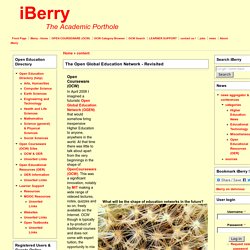
At present, online learners have to work hard to find suitable open courses, textbooks and other people to share their learning. This favors those who already have a good educational background and familiarity with the Internet but now opportunities are opening up for a much larger number of would-be learners who have not had these advantages because of personal circumstances or geographical location.
This is where the future lies! The Purpose of Education Why should mature adults make the effort to educate themselves beyond the level they have already reached? Saving the Human Race (?) Think of the many problems facing us - over-population, climate change, pollution, food and energy crises, economic, health and natural disasters - not to mention human aggression. Open Learning.
How To Attribute Creative Commons Photos. About. Want to let people share and use your photographs, but not allow companies to sell them?
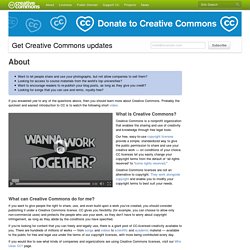
Looking for access to course materials from the world’s top universities? Want to encourage readers to re-publish your blog posts, as long as they give you credit? Looking for songs that you can use and remix, royalty-free? If you answered yes to any of the questions above, then you should learn more about Creative Commons. Probably the quickest and easiest introduction to CC is to watch the following short video: Basic Guide To OER. What is Creative Commons? Creative Commons is a non-profit organization that has released a set of free and voluntary copyright licenses.
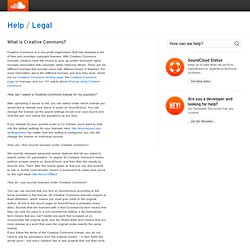
With Creative Commons licenses, creators have the choice to give up certain exclusive rights normally associated with copyright, while retaining others. There are six different licenses that provide users with different levels of freedom. For more information about the different licenses and how they work, check out our Creative Commons landing page, the Creative Commons page on licenses, and our 101 article about Sharing using Creative Commons. How can I select a Creative Commons license for my sound(s)? After uploading a sound or set, you can select under which license you would like to release your piece of audio on SoundCloud. If you release all your sounds under a CC license, you'd want to look into the default settings for your licenses here: No matter how this setting is configured, you can still change the license on individual sounds. 4314 11764 1 PB. Flexspan. AlastairarticleOER. The Future of MOOCs · UOBETT.
Q: Is information available from the older, initial USA courses available – about research on taking a MOOC?
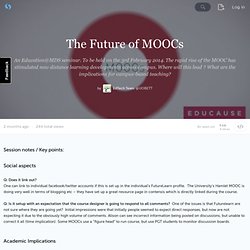
If pitching it at CPD – could incorporate costs. One MOOC has been offering an exam at a cost of £150 which will give certificate. DS106, a technical MOOC, has to be completed before getting a job at Google. There are moves in Canada to allow credits to your degree from MOOC, based on Open University-type model. Other MOOCS had the option to write an essay with peer marking; you had to agree to mark 5 others. Q: Are we tying our MOOCs to specific courses? Dental Photography course is currently a unit of a module on the MSc. Q: What level are the University MOOCs aimed at? MOOCs – who, what, why, when, how ? (with image, tweets) · UOBETT. Language. Coursera expands foreign-language classes with help of new international partners. Providers of massive open online courses (MOOCs) tend to be based in elite pockets of the United States (Silicon Valley and Boston, for example), but their students increasingly come from all corners of the world.

And to attract and accommodate a more global student body, online education startup Coursera on Thursday said that it had added even more school partners, about half of which are international, to offer more courses reflecting different languages, perspectives and disciplines. The Palo Alto-based company said it had added 29 new academic partners, 16 of which are international, nearly doubling its list of institutional partners (you can see a full list of new schools below).
With its new partners, the startup will not only offer courses in French (it already launched a course with the Ecole Polytechnique Fédérale de Lausanne), but also Spanish, Italian and Chinese. But that fast growth has not come without some pain. Association of Governing Boards. Forget basketball and March Madness.
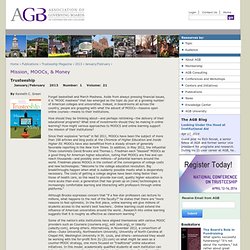
Aside from always pressing financial issues, it is “MOOC madness” that has emerged as the topic du jour at a growing number of American colleges and universities. Indeed, in boardrooms all across the country, people are grappling with what the advent of MOOCs—massive open online courses—means to their institutions. How should they be thinking about—and perhaps rethinking—the delivery of their educational programs? What kind of investments should they be making in online learning? How might various approaches to MOOCS and online learning support the mission of their institutions? Since their explosive “arrival” in fall 2011, MOOCs have been the subject of more than 100 articles and blog posts at the Chronicle of Higher Education and Inside Higher Ed.
Although Brooks expresses concern that “if a few star professors can lecture to millions, what happens to the rest of the faculty?” What is a MOOC? Points on a Continuum In 1976, Bernard J.